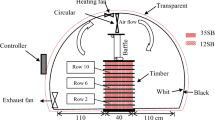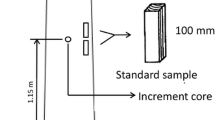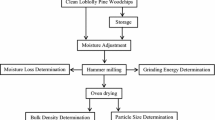Abstract
Plantation-grown progenies of Melia composita Willd. were studied for variability in several physical properties: density, radial and tangential shrinkage, longitudinal permeability of heartwood and sapwood. Furthermore, flat-sawn planks from each of the progeny were subjected to a quick-drying test for determination of kiln-drying schedule. The mean density of the species was 0.39 g cm−3 and the wood may be categorized as light wood. Mean radial shrinkage (%) for the species was 2.8% with progeny-wise variation in radial shrinkage from 1.56 to 4.11%. Mean tangential shrinkage (%) for the species was 5.54% with progeny-wise variation in tangential shrinkage from 3.69 to 7.71%. The resultant tangential-radial shrinkage ratio was 1.98 (less than two), which suggests that the wood is relatively stable with respect to drying behavior. Mean sapwood and heartwood longitudinal permeability of the species were 3.38 and 2.02 Darcy, respectively. Higher longitudinal permeability of sapwood and heartwood indicate better drying and preservative properties of the species. Terazawa quick-drying test method suggests that the species is less susceptible to drying defects. During the test, only moderate checks and cracks were observed. A tentative kiln-drying schedule was recommended based on these results.







Similar content being viewed by others
References
Anonymous (2016) Equilibrium relative humidity-saturated salt solutions. www.omega.com. Accessed on 30 Mar 2016
Bahri S, Kumar S (1982) Permeability studies on Eucalyptus hybrid. J Timber DevAssoc India 28(3):32–43
Basri E, Hadjib N, Saefudin (2005) Basic properties in relation to drying properties of three wood species from Indonesia. J For Res 2(1):49–56
Brandao ATO (1992) A screening to select kiln schedule. IPEF Int Piracicaba 2:20–24
Chowdhury KA, Ghosh SS (1958) Indian woods their identification, properties and uses, vol 1. Manager Publications, Delhi, p 304
Effah B (2014) The susceptibility of Cola nitida and Funtumia elastica to some drying defects. Int J Sci Technol 4(2):37–40
IS:1708 (1986) Methods of testing of small clear specimens of timber. Bureau of Indian standards, Indian Standards Institution, Manak Bhavan, New Delhi
Kumar S, Chaubey BB (1987) Studies on permeability variation in tropical Indian hardwoods: effect of specific gravity and moisture content. J Timber Dev Assoc (India) 33(1):35–49
Kumar A, Praveen Dobhal S, Sharma S, Ahmed N, Rawat US (2013) Genetic screening and improvement of Melia composita Willd. Ann For 21(2):189–196
Ofori J, Brentuo B (2005) Green moisture content, basic density, shrinkage and drying characteristics of the wood of Cedrelia odorata grown in Ghana. J Trop For Sci 17(2):211–223
Ofori J, Brentuo B (2010) Drying charecterstics and development of kiln drying schedules for the wood of Alstonia boonei, Antrocaryon micraster, Bombax buonppozense, Dialium aubrevillei and Sterculia rhinoptala. Ghana J For 26:50–60
Sheikh AA, Kyoung CS (2009) Observation of liquid permeability related to anatomical charecterstics in Samanea saman. Turk J Agric For 33:155–163
Simpson WT, Sagoe JA (1991) Relative drying times of 650 tropical woods-estimation by green moisture content, specific gravity and green weight density. United States Department of Agriculture and forest service, Forest products laboratory, General Technocal Report FPL-GTR-71
Soe A, Win CN, Hlaing SS (2013) Study on proposed kiln schedule of some commercial hardwood species from Tanintharyl region. Republic of the Union of Myanmar, Ministry of Environmental Conservation and Forestry, Forest Research Institute, Myanmar, p 22
Sood D (2014) Wood and wood products in India 2014. Global Agriculture Information System, USDA Foreign Agriculture Service, GAIN report No.: IN4049
Tan YE, Lim NPT, Gan KS, Wong TC, Lim SC and Thilagwathy M (2010) Testing methods for plantation grown tropical timbers. Report of ITTO project on improving utilizatio and value adding of plantation timbers from sustainable sources in Malaysiano. PD 306/04 (1), Forest research institute, Malaysia
Terazawa S (1965) Methods for easy determination of kiln drying schedule of wood. Jpn Wood Ind 20(5):216–226
Walker JCF (2006) Primary wood processing: principles and practice, 2nd edn. Springer, Dordrecht, p 596
Acknowledgements
The authors would like to express sincere thanks to Dr. Ashok Kumar, scientist, Genetics and Tree Propagation Division, Forest Research Institute, Dehradun (India) for providing wood material and extending encouragement and support to carry out this study.
Author information
Authors and Affiliations
Corresponding author
Additional information
Project Funding: The study is a part of M.Sc. thesis works funded by Forest Research Institute (Deemed) University, Dehradun (India).
The online version is available at http://www.springerlink.com
Corresponding editor: Yu Lei.
Rights and permissions
About this article
Cite this article
Kumar, S., Kelkar, B.U., Mishra, A.K. et al. Variability in physical properties of plantation-grown progenies of Melia composita and determination of a kiln-drying schedule. J. For. Res. 29, 1435–1442 (2018). https://doi.org/10.1007/s11676-017-0527-z
Received:
Accepted:
Published:
Issue Date:
DOI: https://doi.org/10.1007/s11676-017-0527-z




